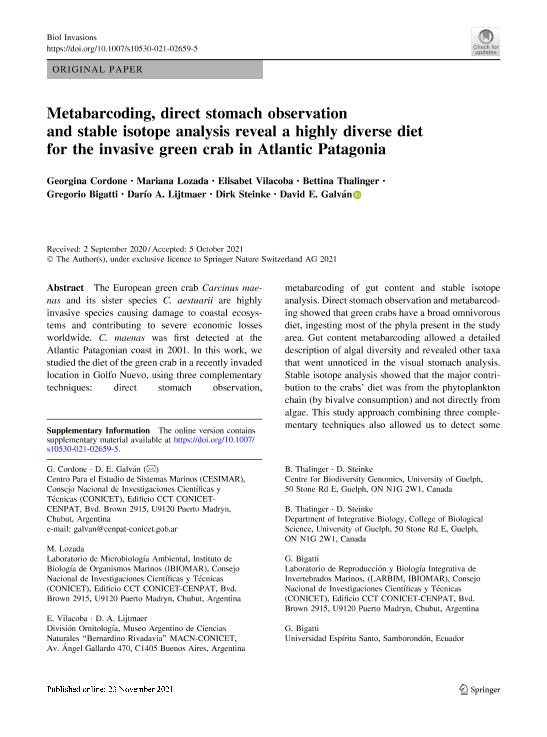Mostrar el registro sencillo del ítem
dc.contributor.author
Cordone, Georgina Florencia

dc.contributor.author
Lozada, Mariana

dc.contributor.author
Vilacoba, Elisabet

dc.contributor.author
Thalinger, Bettina
dc.contributor.author
Bigatti, Gregorio

dc.contributor.author
Lijtmaer, Dario Alejandro

dc.contributor.author
Steinke, Dirk
dc.contributor.author
Galvan, David Edgardo

dc.date.available
2022-09-27T10:54:44Z
dc.date.issued
2021-11
dc.identifier.citation
Cordone, Georgina Florencia; Lozada, Mariana; Vilacoba, Elisabet; Thalinger, Bettina; Bigatti, Gregorio; et al.; Metabarcoding, direct stomach observation and stable isotope analysis reveal a highly diverse diet for the invasive green crab in Atlantic Patagonia; Springer; Biological Invasions; 24; 2; 11-2021; 505-526
dc.identifier.issn
1387-3547
dc.identifier.uri
http://hdl.handle.net/11336/170548
dc.description.abstract
The European green crab Carcinus maenas and its sister species C. aestuarii are highly invasive species causing damage to coastal ecosystems and contributing to severe economic losses worldwide. C. maenas was first detected at the Atlantic Patagonian coast in 2001. In this work, we studied the diet of the green crab in a recently invaded location in Golfo Nuevo, using three complementary techniques: direct stomach observation, metabarcoding of gut content and stable isotope analysis. Direct stomach observation and metabarcoding showed that green crabs have a broad omnivorous diet, ingesting most of the phyla present in the study area. Gut content metabarcoding allowed a detailed description of algal diversity and revealed other taxa that went unnoticed in the visual stomach analysis. Stable isotope analysis showed that the major contribution to the crabs' diet was from the phytoplankton chain (by bivalve consumption) and not directly from algae. This study approach combining three complementary techniques also allowed us to detect some differences in the diet between sexes, which suggests that male and female crabs are not as ecologically equivalent as previously thought. Besides, we detected sequences corresponding to C. aestuarii suggesting that the green crab Patagonian population is a hybrid of both sister species. These findings are key to understanding the impacts green crabs can have on the local ecosystem.
dc.format
application/pdf
dc.language.iso
eng
dc.publisher
Springer

dc.rights
info:eu-repo/semantics/openAccess
dc.rights.uri
https://creativecommons.org/licenses/by-nc-sa/2.5/ar/
dc.subject
CARCINUS AESTUARII
dc.subject
CARCINUS MAENAS
dc.subject
ENVIROMENTAL DNA
dc.subject
ROCKY SHORE ECOLOGY
dc.subject
TROPHIC INTERACTIONS
dc.subject.classification
Ecología

dc.subject.classification
Ciencias Biológicas

dc.subject.classification
CIENCIAS NATURALES Y EXACTAS

dc.title
Metabarcoding, direct stomach observation and stable isotope analysis reveal a highly diverse diet for the invasive green crab in Atlantic Patagonia
dc.type
info:eu-repo/semantics/article
dc.type
info:ar-repo/semantics/artículo
dc.type
info:eu-repo/semantics/publishedVersion
dc.date.updated
2022-09-13T11:05:08Z
dc.journal.volume
24
dc.journal.number
2
dc.journal.pagination
505-526
dc.journal.pais
Alemania

dc.description.fil
Fil: Cordone, Georgina Florencia. Consejo Nacional de Investigaciones Científicas y Técnicas. Centro Científico Tecnológico Conicet - Centro Nacional Patagónico. Centro para el Estudio de Sistemas Marinos; Argentina
dc.description.fil
Fil: Lozada, Mariana. Consejo Nacional de Investigaciones Científicas y Técnicas. Centro Científico Tecnológico Conicet - Centro Nacional Patagónico. Instituto de Biología de Organismos Marinos; Argentina
dc.description.fil
Fil: Vilacoba, Elisabet. Consejo Nacional de Investigaciones Científicas y Técnicas. Oficina de Coordinación Administrativa Parque Centenario. Museo Argentino de Ciencias Naturales "Bernardino Rivadavia"; Argentina
dc.description.fil
Fil: Thalinger, Bettina. University of Guelph; Canadá
dc.description.fil
Fil: Bigatti, Gregorio. Consejo Nacional de Investigaciones Científicas y Técnicas. Centro Científico Tecnológico Conicet - Centro Nacional Patagónico. Instituto de Biología de Organismos Marinos; Argentina
dc.description.fil
Fil: Lijtmaer, Dario Alejandro. Consejo Nacional de Investigaciones Científicas y Técnicas. Oficina de Coordinación Administrativa Parque Centenario. Museo Argentino de Ciencias Naturales "Bernardino Rivadavia"; Argentina
dc.description.fil
Fil: Steinke, Dirk. University of Guelph; Canadá
dc.description.fil
Fil: Galvan, David Edgardo. Consejo Nacional de Investigaciones Científicas y Técnicas. Centro Científico Tecnológico Conicet - Centro Nacional Patagónico. Centro para el Estudio de Sistemas Marinos; Argentina
dc.journal.title
Biological Invasions

dc.relation.alternativeid
info:eu-repo/semantics/altIdentifier/url/https://link.springer.com/10.1007/s10530-021-02659-5
dc.relation.alternativeid
info:eu-repo/semantics/altIdentifier/doi/http://dx.doi.org/10.1007/s10530-021-02659-5
Archivos asociados
